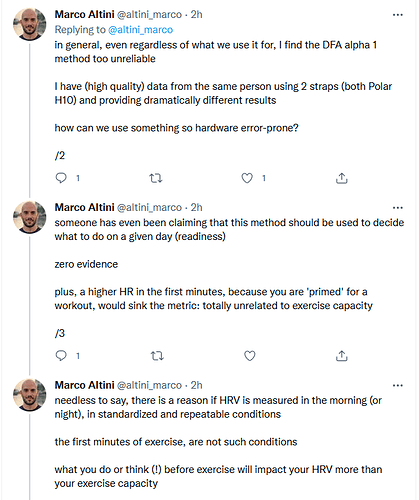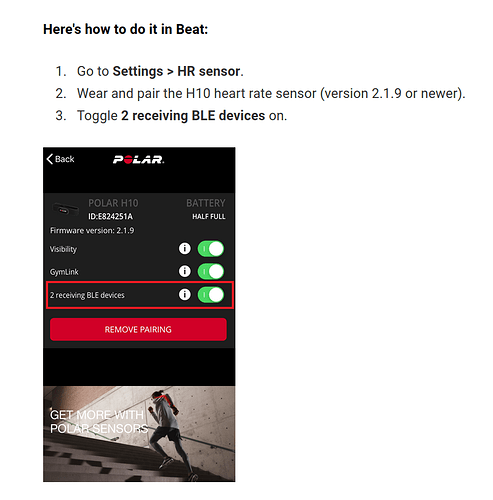Here’s a paper I like to share. Polar has validated their H10 and compared to several other HRMs.
My takeaway is that the strap has some effect on reading quality, too.
I’ve only used Polar and Garmin premium straps, so that may help reduce artifacts.
Cycling should be the easiest sport to collect rr intervals. I don’t get many artifacts while running, either.
And here’s another validation for Polar’s rr interval quality.
Here’s another cool paper:
The Polar H10 appears to be the most accurate wearable device when compared to criterion measures and even appears to supersede traditional methods during exercise. However, currently, the H10 must be paired with a watch to enable the raw data to be extracted for HRV analysis if users need to avoid using an app (for security or data ownership reasons) which incurs additional cost.
I get that there are other HRMs that will give rr intervals. However, I cant find any validation of Garmin HRM-Dual. And you can search Pubmed and find that Polar HRMs are the gold standard for research settings. I am certainly biased to Polar.
thanks for a nice read.
Thanks for sharing! I’m happy to see someone with authority speak about how difficult it is to use alpha1 reliably. But the masses won’t read into it and continue to blindly use alpha1.
He states things better than me:
I’m 69 and recently discovered that I have chronically low HRV. I’ve been taking HRV readings for a couple of years, which were not low but those were taken with Wahoo Tickr and typically after a 10-minute guided mediation, which I now know raised HRV.
I received an Oura ring for Christmas and have been comparing the overnight reading with 4 apps (Elite HRV, HRV4Training, Kubios, HRVLogger) using a Polar H10. Are all consistently in the 17-21 ms for rMSSD. The good news is that the trend is what is important and a low HRV does not necessarily mean a low readiness score, as I regularly get good-to-go scores. But after looking online, the potential bad news is that a chronically low HRV predicts a higher risk of heart disease and mortality from several causes. https://www.ahajournals.org/doi/10.1161/01.CIR.102.11.1239 Although HRV does reduce with age, mine is lower than my average peers, according to EHRV charts. I wanted to throw this out for discussion in case others have a similar pattern and see if anyone has been able to raise their HRV. As for me, I follow all the recommendations to increase HRV, including good sleep, meditation, healthy diet, and (of course) exercise of around 100 miles cycling per week.
Biofeedback is said to increase HRV and the Elite HRV app has a built-in module for biofeedback. I plan to try that (20 minutes twice per day) and see if it makes a difference.
Nonetheless after 8 months I’ve found HRV morning readings not to have any correlation with me and just gave up as of last week.
I’m my case I was using the IPhone camera that Marco states to be great.
Regards
Oh, but alpha1 is just a characteristic of HRV, so two different things.
I don’t find HRV useful enough to collect every morning. I’ve collected and studied rr intervals a whole lot, but I still think how I feel upon waking is my best indicator of readiness. I also pay attention to how my legs and body feel when I walk downstairs and then upstairs to my home office (do my muscles feels any DOMS sting, general fatigue, aches, etc.).
But for some, correlating alpha1 to some workload seems to work. Me included. Too bad it’s not a plug-and-play method.
I’m like you…at 42 I have a lower HRV score in all the apps compared to the general population. I also have a lower than average maxHR for my age. That’s just how we’re built, I guess.
A low maxHR means you (probably) pump more blood with every stroke, and therefore don’t need to “rev high”.
W.r.t. your previous comment on collecting HRV data, it’s just another tool in the toolkit, designed to help make the right decision. That decision is whether to rest another day, or continue with training. It should be used in conjunction with other tools, like “feel”, TSB, readiness, etc.
Sure, I understand stroke volume and all that stuff. I want to understand it better though and I’m curious as to why it is what it is.
I get it. I love tools. However, none of those tools…daily HRV, TSB, etc., etc, take priority over RPE. In fact, I would say using too many metrics can poorly inform many athletes.
Just remember that RPE is based on how you felt the session went, and not how you feel the next day.
Got ya. I should clarify. Feeling over gadgets for how today is going to go. Feeling over gadgets for how training should go.
Also, those are only my opinions. I’m an authority on nothing.
A new paper by Dr. Rodgers.
@MedTechCD @Inigo_Tolosa @Luisma_Gallego_Soy_P
I had no problem adding BLE devices until HRValph was installed. Maybe there is some bug in the application settings. unfortunately now, even after removing the HRVAlpha data field, I cannot add a BLE device and connect to the previously added.
Thanks for all of that. Yes H10 (H9 too?) is the gold standard. But even if the Garmin Dual is 95% as good, could that be identical in real world application? I mean if your DFA-A1 was 0.87 or 0.85 would you change your workout at all?
Side note, I just bought a H10. Hopefully arriving next Monday (my Garmin Premium module died (1 too many times accidentally in the wash) so I only have a 7 yr old TICKR now).
That’s how my TICKR died. (bought 2015 , went into the wash and was never good again.
So… since my original TICKR, (circa 2012-2013) is showing signs of loss signal and has a lot of artifacts and such and perchance there was a -30% discount on the H10, i got it yday and did the first workout w it today. (firmware 3.1.1)
Sadly, I’m disappointed. Perhaps it’s due to the fact that I’m using an off-market, 3rd Party HR Strap. (I didn’t want to use the new one since supposedly the old one still works. I guess I’ll have to try)
AlphaHRV connected via ANT+
Garmin - Connected via BLE (same device as the alphaHRV)
For some reason, when i connected alphaHRV using BLE, I am not able to connect to the 2nd BLE connection that the H10 has. Seems like alphaHVR just blocks anything else from connecting to it again.
I see. Just the once? Both my TICKR and Garmin Premium had been through the wash once each. This was the Premium’s second time through but didn’t make it. Being waterproof, I’d expect them to make it. Not that I did it on purpose.
Use both bands so you have a clean one for each workout. I’d suggest using the Polar band for HRV work and your existing band for HR recording only. I have 4 bands and 2 modules. I like having a clean band ![]()
You need to enable multi BLE on the device. The Polar Flow or Polar Beats app with help with that.
Yes. only once. Dunno bout the Garmin premium, but these typical HRMs are only waterproofed based on that one tiny band of rubber gasket type thing. Wonder how the triathletes use their HRMs during the swim.
I have like many bands(min 4x inclusive original and 3rd party) and my modules (2x Tickr, 1x Wahoo Blue, 1x 4iiii, 1x Garmin Run and now Polar H10 - but seems like now most dont work properly anymore). I cherish my original bands (cos they costs so much and I didn’t have issues w/ them until now - meaning HRV artifacts. I’ll give it a go a/ the Polar Band tomorrow or such.) I wash my bands after every workout.
Yes I did that. But Polar’s Apps is a total mess. 2 diff apps for the same sort of purpose (I only wanted to update the firmware and didn’t (yet) know about having to use it to enable 2x BLE).
And to sign up to polar, it really makes you cringe w/ the amount of “stuffs(T&C)” they make you agree on. I mean, sure, FB also has a lot of these under the hood, but we’re oblivious to it. Polar ones just makes it “in your face”. You’ll see it when you sign up (if not already)
But yes even after enabling 2x BLE, once alphaHRV is connected to the BLE, no other apps can see the 2nd BLE connections anymore. (tried on iphone and ipad)
H9 is usualy considered just as good but it has only one BLE channel.
I will retest my Garmin dual with the experience and knowledge I have now. Must say that I learned a lot regarding maximizing signal quality since using the HRV apps and there are enough reports around that the different Garmin Dual models perform well.
The N° 1 reason I wanted a Polar, was to be able to use Fatmaxxer.
A lower signal quality will not alter your a1 in a subtle way. Too many signal drops (missed beats) will get you an unusable trace. A single dropped beat messes with the entire measurement window (2 min for Fatmaxxer and Runalyze - 200 beats for AlphaHRV). So if you get regular missed beats, you may end-up with very little measurement windows that can be trusted.
What device are you using?
Remember that the app is still in Beta.
I can only comment on my experiences with my own hardware.



